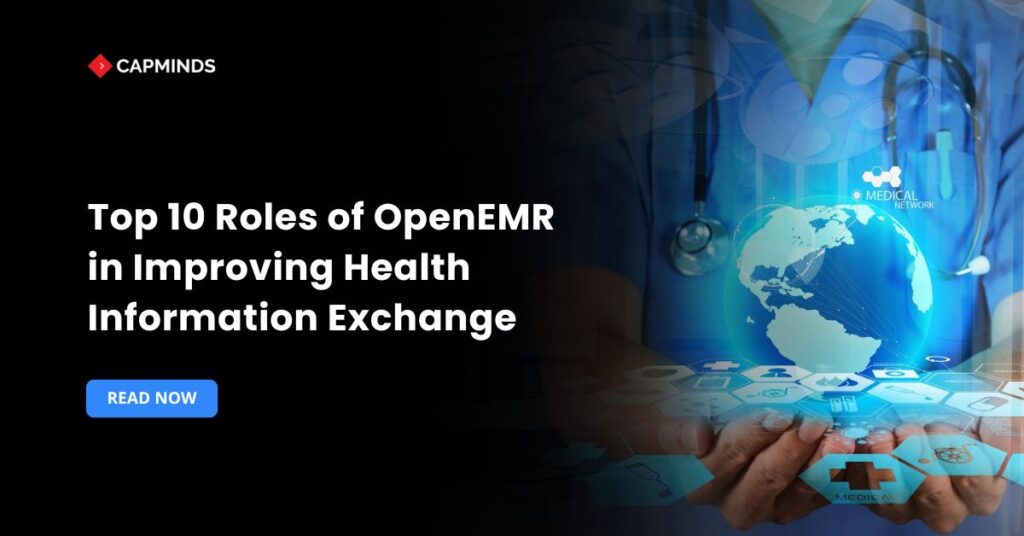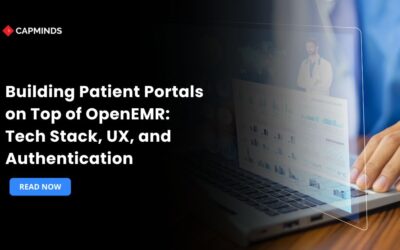Top 10 Roles of OpenEMR in Improving Health Information Exchange
As we all know, OpenEMR is an open-source electronic medical records (EMR) software that is designed to help healthcare providers manage patient records and streamline their workflow. It is a comprehensive system that includes features for patient demographics, appointment scheduling, medical billing, clinical documentation, prescription management, and much more.
As of 2025, OpenEMR also includes FHIR API support, Telehealth integrations, and enhanced patient portals, making it more interoperable and patient-centered. In this blog post, we have shared the top 10 roles of OpenEMR in improving health information exchange among healthcare systems.
OpenEMR – An Open-Source EHR System
OpenEMR was originally developed by Synitech Incorporated in 2000. It is dedicated to the “adoption of open architecture in the medical industry, integrating a wide variety of medical records and a diverse network of nationwide billing companies.” Synitech developed OpenEMR in 2001 as MP Pro. In 2002, it was redesigned to be HIPAA compliant and renamed “OpenEMR.”
Over time, OpenEMR has evolved and grown, with contributions from a community of developers, users, and organizations worldwide. The system is written in PHP and uses a MySQL database to store patient data. OpenEMR is licensed under the GNU General Public License and is free to use, modify, and distribute. The latest OpenEMR version as of 2025 supports:
- Cloud deployment
- Docker containers
- Includes native support for international coding systems like SNOMED CT and LOINC.
OpenEMR is widely used by healthcare providers worldwide, including hospitals, clinics, and private practices. Its user-friendly interface, flexible customization options, and extensive features make it a popular choice for healthcare organizations of all sizes. It continues to evolve and improve with new features, enhancements, and integrations.
Recent integrations with national Health Information Exchanges (HIEs) and certification by ONC Health IT for interoperability standards make OpenEMR a strong candidate for healthcare systems aiming for full compliance and nationwide data sharing.
What is Health Information Exchange?
Health information exchange (HIE) is the electronic sharing of healthcare-related information between healthcare providers, such as hospitals, clinics, pharmacies, and laboratories.
HIE allows for the secure exchange of patient information, including medical histories, test results, prescriptions, and other important health data, between different providers, allowing for better care coordination.
Modern HIEs in 2025 also incorporate machine learning for predictive care alerts and support patient-directed data sharing through mobile health apps.
What is the Goal of Health Information Exchange?
The goal of HIE is to provide timely access to accurate patient information, regardless of where the patient received care. This can improve the quality of care and patient outcomes by giving providers a more complete picture of a patient’s health history and current treatment plan.
Another growing objective in 2025 is to ensure public health reporting compliance and pandemic readiness through seamless integration of real-time surveillance systems.
What Facilitates Health Information Exchange?
HIE is facilitated by health information exchange networks, which are often operated by non-profit organizations or government agencies. These networks use secure protocols and standards to ensure the confidentiality and security of patient information during transmission and storage.
In 2025, HIEs are increasingly utilizing TEFCA-compliant frameworks, making it easier for systems like OpenEMR to participate in trusted data exchange networks nationwide.
Related: Can large clinics use OpenEMR? [Top 8 challenges & shotgun solutions]
Role of OpenEMR in Improving Health Information Exchange
1. Centralized Patient Records
OpenEMR provides a centralized location for healthcare providers to store and access patient health records, including medical histories, diagnoses, test results, and more. This allows for seamless access to up-to-date patient information, regardless of where the patient received care.
With FHIR-enabled APIs, OpenEMR now enables smoother record exchange with external HIE networks and third-party health apps.
2. Improved Care Coordination
By facilitating the sharing of patient information, OpenEMR can help improve care coordination among different healthcare providers.
This allows for a more comprehensive view of a patient’s health status and treatment plan. Through recent partnerships with national HIEs, OpenEMR supports cross-platform communication across different EMRs for collaborative care delivery.
3. Real-Time Data Access
OpenEMR can provide real-time access to patient information, allowing healthcare providers to make informed decisions quickly and efficiently.
The 2025 version includes real-time alerts for medication interactions and abnormal test results using AI-based clinical decision support.
4. Secure Information Exchange
OpenEMR provides secure information exchange, ensuring that sensitive patient information is protected during transmission and storage. OpenEMR now supports end-to-end encryption, multi-factor authentication, and is fully compliant with TEFCA and 21st Century Cures Act requirements.
5. Improved Patient Safety
By allowing for better coordination of care and access to up-to-date patient information, OpenEMR can help improve patient safety and reduce medical errors.
6. Enhanced Analytics
OpenEMR provides robust analytics capabilities, allowing healthcare providers to analyze patient data and identify trends, gaps in care, and areas for improvement. The new analytics dashboard includes social determinants of health tracking and predictive modeling tools to proactively manage high-risk populations.
7. Cost Savings
OpenEMR can help reduce healthcare costs by streamlining workflows, reducing duplication of services, and improving overall efficiency.
8. Patient Engagement
OpenEMR provides patient portals and other tools that can help engage patients in their care and provide them with access to their health information. Recent features include telehealth visit scheduling, real-time chat with providers, and mobile health monitoring integration.
9. Compliance
OpenEMR can help healthcare providers comply with regulatory requirements, such as HIPAA and Meaningful Use. In 2025, OpenEMR is certified for ONC Health IT Cures Update requirements and supports automated public health reporting and patient access APIs.
10. Customizability
OpenEMR is highly customizable, allowing healthcare providers to tailor the system to their specific needs and workflows, enhancing the overall effectiveness of the health information exchange. Developers now benefit from built-in support for FHIR modules, custom RESTful APIs, and a plug-and-play architecture for interoperability.
CapMinds OpenEMR Customization and Integration Service
CapMinds OpenEMR equips clinicians with the best features and ways to integrate. It makes their workflows more efficient and filtered.
The integrated features will allow them to combine the ability of patient record management with conceptual and concurrent reminders.
This enhances the process of decision-making and improves patient care and quality.
- At CapMinds, OpenEMR custom solutions are developed with much care and accuracy to match the special practice needs.
- It will be low-cost and the perfect budget solution for your practice’s long-term future.
- CapMinds OpenEMR prioritizes secure data management & ensures compliance with industry regulations, offering healthcare providers peace of mind.
Get the best technologies and HIPAA-compliant and efficient OpenEMR from CapMinds that can be tailored to fit your practice.
Our OpenEMR services facilitate a Modern User Interface (UI), customization, production support & training. It also facilitates billing, reporting, specialty enhancements, clearing house integrations, e-prescribing, cloud, and more.
“Get the most experienced, proven, and perfect professional support for your OpenEMR.”




